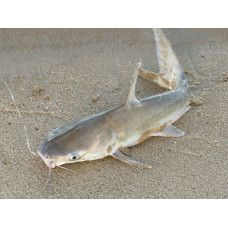Latin name
Plicofollis argyropleuron
Other name
Broadbent's catfish, spoon-nosed catfish, large-scaled catfish, sharp-headed catfish, sand catfish.
Identification
The species was first described by Achille Valenciennes in 1840, originally within the genus Arius.
Head depressed and elongated, 27-36% (average 32%) of head length. Occipital process narrow, always curved. Eyes deep set. Mouth small, 24-40% (average 31%) of head length wide. Gill blades absent on posterior side of first 2 gill arches. The posterior epithelial ridges of the palate are transverse. The depth of the caudal pedicle is 1.3 to 2.1 inches of its length.
Features of fish fins
Dorsal spines (total): 1; Anal spines: 0.
Fish colouring
The body of these fish is silvery gray and the open shield is heavily striped.
Distribution
They inhabit the Indo-West Pacific in the waters of New Guinea, Australia, South and Southeast Asia.
Habitat
A tropical marine brackish benthic species.
Size
Its maximum total length reaches 50 cm (20 inches).
Behavior
Likes to swim in coastal waters on soft bottoms.
Food and feeding habits
The diet of these fish includes bony fish, benthic crustaceans including crabs and shrimp, detritus, mollusks, polychaete and ringworms, algae, and mud.
Reproduction
Eggs hatch in the mouth. Juveniles continue to hide in the males' mouths for the first 2 months.
Fishing
Longsnouted catfish are harvested commercially and for aquarium culture.
Relationship with a person
Traumatogenic for humans.
| Classification | |
| Phylum | Chordata |
| Class | Actinopterygii |
| Squad | Siluriformes |
| Family | Ariidae |
| Genus | Plicofollis |
| Species | P. argyropleuron |
| Features | |
| Conservation status | Not Evaluated |
| Habitat | Bottom |
| Life span, years | No information |
| Maximum body weight, kg | No information |
| Maximum length, cm | 50 |
| Sailing speed, m/s | No information |
| Threat to people | Edible |
| Way of eating | Predator |
Longsnouted catfish
Tags: longsnouted catfish


